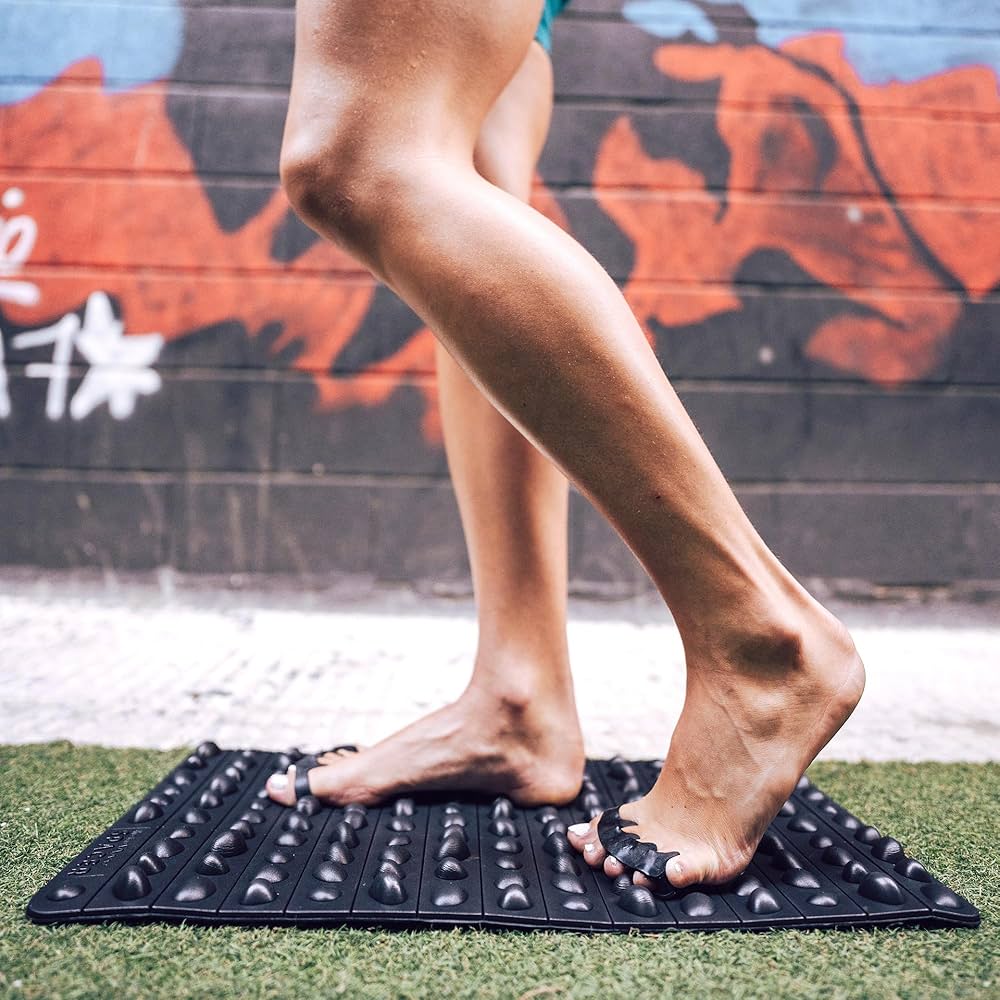

Hey Guys, Did you ever wonder what that black mat with all the bumps is? You may have seen Coach Trish’s son Jayden using it as a car mat but it's actually for you!
We want to share some information on foot health and for a stronger foundation for you.
There are over 200,000 sensory nerve endings in the sole of each foot, making it one of the most nerve-rich parts of the body. Most of the time, we cover these nerve endings with shoes, and the feet rarely have the opportunity to be exposed to uneven surfaces and different terrain. Feet needs to be stimulated and challenged to train responsiveness and build strength and stability. The Rock Mat wakes the feet and strengthens the foot brain connection by activating those sensory nerve endings. The feet quickly send signals to the brain about their surroundings, and the brain has to send commands to the relevant parts of the body to stay upright. The Rock Mat benefits in activating the feet in a number of ways:
1. Stimulates Nerve Endings: activates sensory receptors,
2. Improves neural connectivity and overall foot sensitivity
3. Enhances Proprioception: mimicking natural uneven surfaces
4. Helps improve balance, coordination, and spatial awareness.
5. Relieves Foot Tension: firm foam nodules apply targeted pressure to the soles, releasing tension and alleviating discomfort
6. Improves Circulation: promotes blood flow in the feet, which can aid in recovery, reduce fatigue, and support overall vascular health.
If you are new to using the Rock Mat we recommend putting a towel over the mounds to soften it, or place the mat on top of a softer surface like carpet. Once accustomed to acupressure, integrate the Rock Mat into training (lunges, squats, mobility). Note body's response; if it's too much, reduce pressure with a towel and massage knot.
Some common questions include:
1. What is it made out of?
The Rock Mat is made with firm foam.
2. How long can I stand on it for?
If you’re new to standing on the Rock Mat, start off with 5-10 minutes. As you become comfortable, feel free to increase the time frame and add movement.
3. How do I wash it?
You can clean your Rock Mat with mild soap and water. Let them air dry completely before using them again. Alternatively, you can use a gentle cleansing wipe.
4. How hard is it?
The level of hardness depends on the individual. It is made with firm foam mounds to allow for pressure on the sole of the foot. If the mat is too firm at first, try putting a towel over the mounds to soften it, or place the mat on top of a softer surface like carpet.
5. How long will it take to see results from using the Rock Mat?
The time it takes to see results can vary depending on the individual and the severity of the foot condition. Some people may notice improvements instantly, while others may take weeks to several months. Consistency is key, so use the Rock Mat regularly as part of your foot care routine.
Here are some exercises for you to try on the Rock Mat:
Foundational Standing Exercises
1.Static Standing (2 feet)
2.Weight Shifts (front/back, side/side)
3.Toe Lifts & Spreads
4.Heel Raises (double leg → single leg)
5.Toe Raises (double leg → single leg)
6.Mini Squats
7.Forward Folds / Hamstring Stretch
8.Pelvic Tilts While Standing
9.Foot Doming (Short Foot Exercise)
Single-Leg Balance & Stability Drills
10.Single Leg Balance (eyes open → closed)
11.Single Leg Toe Taps (Clock Taps) – Tap the floor at various positions like on a clock face (12, 3, 6, 9)
12.Single Leg Airplane Hip Opener – Hinge at the hip, reaching forward or side and then rotate to open up hips
13.Single Leg Good Mornings – Hands behind head, hinge from hips with a flat back 14.Single Leg RDL (Romanian Deadlift) – Maintain slight knee bend, hinge with control 15.Single Leg Calf Raises
16.Hip CARs (Controlled Articular Rotations) on Rock Mat
17.Single Leg Mini Squats
18.Single Leg Step and Hold – Step onto the mat and freeze in balance 19.Heel to Toe Line Walk (Tandem Walk
Strength & Hinge-Focused Movements
20.Bodyweight Good Mornings (2 feet) – Hands behind head, flat back, soft knees
21.Band-Resisted Good Mornings – Add tension for hamstrings and glutes
22.Kettlebell Deadlifts (Barefoot on Mat)
23.Split Stance Good Mornings – Back foot slightly elevated or on floor
24.Staggered Deadlifts – Mimics running mechanics, loads the foot asymmetrically
Walking & Gait Mechanics
25.Slow Walks Across Rock Mat
26.Tiptoe Walks
27. Heel Walks
28. Inversion Walks (outer foot)
29. Eversion Walks (inner foot)
30. Toe-Off Practice (Big Toe Push Off)
31. March in Place
32. Walking Lunges (Rock Mat under front foot)
33. Farmer Carries on Rock Mat XL